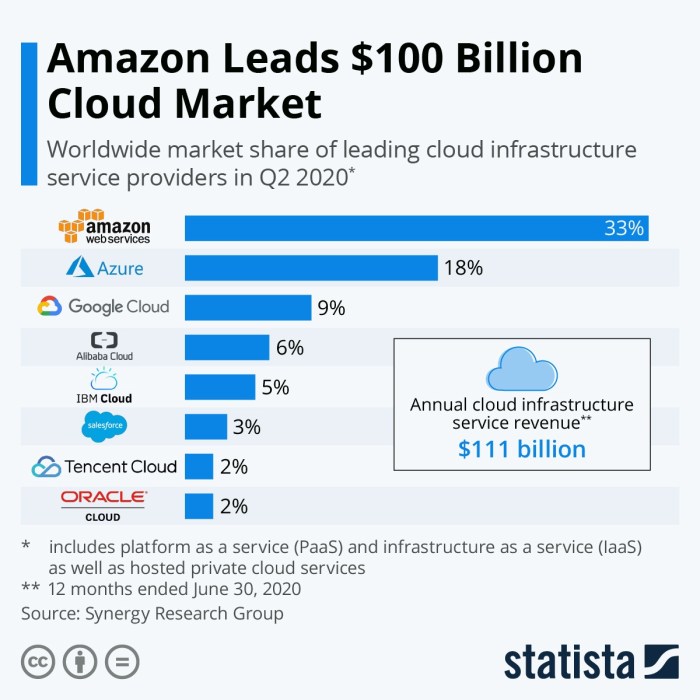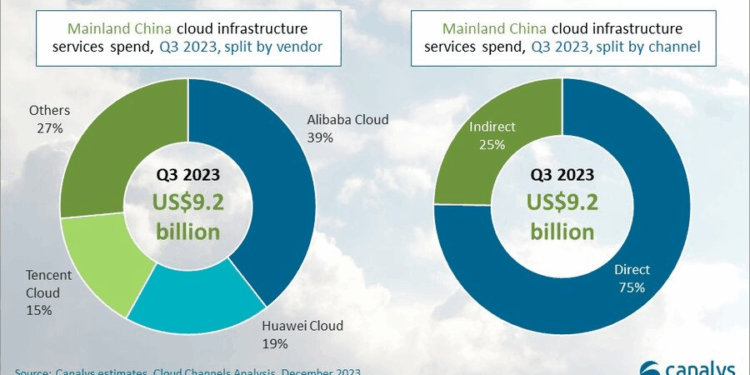
Exploring the realm of cloud market share comparison, we delve into the importance of understanding market shares in the cloud industry. This analysis aims to shed light on the key players and factors influencing market shares, providing valuable insights for businesses and individuals navigating the cloud landscape.
Introduction to Cloud Market Share Comparison

Cloud market share refers to the portion of the cloud computing market that a particular company or service holds in relation to its competitors. It is a measure of the market dominance and popularity of a specific cloud provider.
Comparing cloud market shares is important as it allows businesses and consumers to make informed decisions when choosing a cloud service provider. By understanding the market shares of different companies, users can assess the reliability, performance, and overall value of the services offered.
Significance of Understanding Market Shares in the Cloud Industry
- Market shares provide insight into the competitive landscape of the cloud industry, helping businesses identify key players and potential partners.
- Understanding market shares can aid in predicting future trends and developments within the cloud computing market, enabling companies to adapt their strategies accordingly.
- Comparing market shares allows for benchmarking performance and evaluating the success of different cloud providers in meeting the needs of their customers.
Leading Cloud Service Providers
When it comes to cloud computing, there are several key players in the market that dominate the industry. These leading cloud service providers offer a wide range of services to meet the diverse needs of businesses and individuals alike. Let's take a closer look at the top cloud service providers and compare their market shares.
Amazon Web Services (AWS)
- Amazon Web Services (AWS) is a comprehensive cloud computing platform offered by Amazon.
- Services include computing power, storage options, networking solutions, and more.
- AWS holds a significant market share in the cloud computing industry, making it a top choice for many businesses.
Microsoft Azure
- Microsoft Azure is a cloud computing platform provided by Microsoft.
- Services offered by Azure include virtual machines, app services, AI and machine learning tools, and more.
- Azure is a major player in the cloud market, competing closely with AWS for market share.
Google Cloud Platform (GCP)
- Google Cloud Platform (GCP) is Google's suite of cloud computing services.
- GCP offers services such as computing, storage, databases, machine learning, and data analytics.
- While Google Cloud Platform is a newer player in the market, it has been steadily growing its market share.
IBM Cloud
- IBM Cloud provides a range of cloud computing services, including infrastructure as a service (IaaS) and platform as a service (PaaS).
- Services offered by IBM Cloud include AI, blockchain, Internet of Things (IoT), and more.
- IBM Cloud has a solid market share, particularly in enterprise and business sectors.
Methodology for Comparing Cloud Market Shares
When comparing market shares in the cloud industry, various methods are utilized to gather and analyze data. These methods help provide insights into the competitive landscape and the performance of different cloud service providers.: Market share comparison involves looking at the revenue generated by each cloud service provider within a specific time frame, typically a quarter or a year.
This data is then used to calculate the market share percentage of each provider in relation to the total market size.
Key Factors Considered when Comparing Market Shares
- Revenue Data: The primary factor considered is the revenue generated by each cloud service provider. This data is crucial in determining market share.
- Customer Base: The number of customers using a particular cloud service provider also plays a significant role in market share comparison.
- Service Offerings: The range and quality of services offered by each provider can impact their market share.
Data Sources for Market Share Comparison
- Financial Reports: Publicly available financial reports released by cloud service providers are a key source of data for market share comparison.
- Industry Analyst Reports: Reports from reputable industry analysts provide valuable insights into market trends and the performance of different cloud service providers.
- Surveys and Studies: Surveys and studies conducted by research firms can also offer data on market share and customer preferences in the cloud industry.
Regional Variations in Cloud Market Share
When it comes to cloud market shares, it's essential to consider the regional differences that play a significant role in shaping the landscape of cloud service providers.
Dominant Cloud Service Providers in Different Regions
Across various regions, different cloud service providers emerge as dominant players based on factors such as market penetration, customer preferences, and strategic partnerships. Let's take a closer look at some of the key players in different regions:
- North America:In North America, Amazon Web Services (AWS) holds a substantial market share, followed closely by Microsoft Azure and Google Cloud Platform. These providers have established a strong presence in the region, catering to a wide range of industries and enterprises.
- Europe:The cloud market share in Europe is more evenly distributed among top players such as AWS, Azure, and IBM Cloud. Local providers also play a significant role in certain European countries, offering specialized services tailored to regional needs.
- Asia-Pacific:In the Asia-Pacific region, providers like Alibaba Cloud, AWS, and Microsoft Azure dominate the market. With the rapid digital transformation and growing demand for cloud services in countries like China and India, these providers have seen substantial growth in market share.
Impact of Regional Differences on Cloud Market Share Comparison
Regional variations in cloud market share can have a significant impact on how providers are perceived and utilized in different parts of the world. Factors such as data sovereignty laws, cultural preferences, and regulatory environments can influence the adoption of cloud services and the market share of providers.
Growth Trends and Future Projections
As the cloud computing industry continues to evolve rapidly, it is essential to analyze the growth trends of cloud service providers to gain insights into the future landscape of cloud market shares. By examining current market dynamics and performance metrics, we can project future changes in market shares and understand the factors that will shape the competitive environment.
Growth Trends of Cloud Service Providers
Cloud service providers have been experiencing significant growth in recent years, with key players such as Amazon Web Services (AWS), Microsoft Azure, and Google Cloud leading the market. These providers have been expanding their service offerings, investing in infrastructure, and forming strategic partnerships to cater to the increasing demand for cloud services.
- Amazon Web Services (AWS) has maintained its position as the market leader, with a strong focus on innovation and customer-centric solutions. The company's continuous growth in revenue and market share reflects its ability to adapt to changing market dynamics and meet the evolving needs of customers.
- Microsoft Azure has emerged as a strong competitor to AWS, leveraging its expertise in enterprise solutions and hybrid cloud services. The platform's growth in market share is driven by its focus on digital transformation, AI capabilities, and industry-specific solutions.
- Google Cloud has been gaining momentum in the cloud market, with a focus on data analytics, machine learning, and AI-driven applications. The company's investments in infrastructure and global expansion have positioned it as a key player in the competitive landscape.
Future Market Share Projections
Based on current growth trends and market performance, future projections indicate that AWS, Microsoft Azure, and Google Cloud will continue to dominate the cloud market. However, the competitive landscape is expected to evolve as new players enter the market and existing providers enhance their offerings to stay ahead.
It is projected that AWS will maintain its market leadership position, driven by its strong portfolio of services, global reach, and continuous innovation.
Microsoft Azure is forecasted to experience steady growth, benefiting from its strong presence in the enterprise market and investments in cloud infrastructure.
Google Cloud is expected to expand its market share, leveraging its expertise in data analytics, AI, and machine learning to attract enterprise customers and drive innovation in the cloud space.
Factors Influencing the Future Landscape of Cloud Market Shares
Several factors will influence the future landscape of cloud market shares, including technological advancements, regulatory changes, industry partnerships, and customer preferences. Providers that can adapt to these trends, innovate rapidly, and deliver value-added services will be well-positioned to succeed in the competitive cloud market.
Ending Remarks
In conclusion, the complexities of cloud market share comparison are vast, but armed with the knowledge gained from this discussion, one can navigate the competitive landscape with confidence and strategic foresight. Stay informed, stay ahead in the cloud market game.
Quick FAQs
How is cloud market share calculated?
Cloud market share is typically calculated based on revenue or number of users attributed to each cloud service provider, giving an indication of their market dominance.
Why are regional variations important in cloud market share comparison?
Regional variations offer insights into the preferences and market conditions that influence the dominance of specific cloud service providers in different areas, impacting overall market share comparisons.
What factors influence future projections of cloud market shares?
Factors such as technological advancements, market competition, and shifting consumer demands play a significant role in shaping the future landscape of cloud market shares.











